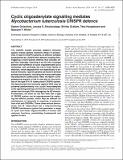Files in this item
Cyclic oligoadenylate signalling mediates Mycobacterium tuberculosis CRISPR defence
Item metadata
| dc.contributor.author | Grüschow, Sabine | |
| dc.contributor.author | Athukoralage, Januka S | |
| dc.contributor.author | Graham, Shirley | |
| dc.contributor.author | Hoogeboom, Tess | |
| dc.contributor.author | White, Malcolm F | |
| dc.date.accessioned | 2019-10-09T16:30:03Z | |
| dc.date.available | 2019-10-09T16:30:03Z | |
| dc.date.issued | 2019-09-26 | |
| dc.identifier | 261681537 | |
| dc.identifier | 1c3d13db-4e42-4972-8c5e-d413cb8ce257 | |
| dc.identifier | 85072588750 | |
| dc.identifier | 000490579200029 | |
| dc.identifier.citation | Grüschow , S , Athukoralage , J S , Graham , S , Hoogeboom , T & White , M F 2019 , ' Cyclic oligoadenylate signalling mediates Mycobacterium tuberculosis CRISPR defence ' , Nucleic Acids Research , vol. 47 , no. 17 , pp. 9259-9270 . https://doi.org/10.1093/nar/gkz676 | en |
| dc.identifier.issn | 0305-1048 | |
| dc.identifier.other | Bibtex: 10.1093/nar/gkz676 | |
| dc.identifier.other | ORCID: /0000-0003-1543-9342/work/63044332 | |
| dc.identifier.other | ORCID: /0000-0002-1666-0180/work/63046273 | |
| dc.identifier.uri | https://hdl.handle.net/10023/18633 | |
| dc.description | Royal Society Challenge Grant [REF: CH160014 to M.F.W.]; Biotechnology and Biological Sciences Research Council [REF: BB/S000313/1 to M.F.W.]. Funding for open access charge: Institutional Block Grant. | en |
| dc.description.abstract | The CRISPR system provides adaptive immunity against mobile genetic elements (MGE) in prokaryotes. In type III CRISPR systems, an effector complex programmed by CRISPR RNA detects invading RNA, triggering a multi-layered defence that includes target RNA cleavage, licencing of an HD DNA nuclease domain and synthesis of cyclic oligoadenylate (cOA) molecules. cOA activates the Csx1/Csm6 family of effectors, which degrade RNA non-specifically to enhance immunity. Type III systems are found in diverse archaea and bacteria, including the human pathogen Mycobacterium tuberculosis. Here, we report a comprehensive analysis of the in vitro and in vivo activities of the type III-A M. tuberculosis CRISPR system. We demonstrate that immunity against MGE may be achieved predominantly via a cyclic hexa-adenylate (cA6) signalling pathway and the ribonuclease Csm6, rather than through DNA cleavage by the HD domain. Furthermore, we show for the first time that a type III CRISPR system can be reprogrammed by replacing the effector protein, which may be relevant for maintenance of immunity in response to pressure from viral anti-CRISPRs. These observations demonstrate that M. tuberculosis has a fully-functioning CRISPR interference system that generates a range of cyclic and linear oligonucleotides of known and unknown functions, potentiating fundamental and applied studies. | |
| dc.format.extent | 12 | |
| dc.format.extent | 2600463 | |
| dc.language.iso | eng | |
| dc.relation.ispartof | Nucleic Acids Research | en |
| dc.subject | Crystal-structure | en |
| dc.subject | DNA cleavage | en |
| dc.subject | CMS complex | en |
| dc.subject | Protein | en |
| dc.subject | Degradation | en |
| dc.subject | Immunity | en |
| dc.subject | System | en |
| dc.subject | CSX1 | en |
| dc.subject | QH301 Biology | en |
| dc.subject | QR180 Immunology | en |
| dc.subject | RM Therapeutics. Pharmacology | en |
| dc.subject | NDAS | en |
| dc.subject | SDG 3 - Good Health and Well-being | en |
| dc.subject.lcc | QH301 | en |
| dc.subject.lcc | QR180 | en |
| dc.subject.lcc | RM | en |
| dc.title | Cyclic oligoadenylate signalling mediates Mycobacterium tuberculosis CRISPR defence | en |
| dc.type | Journal article | en |
| dc.contributor.sponsor | The Royal Society | en |
| dc.contributor.sponsor | BBSRC | en |
| dc.contributor.institution | University of St Andrews. School of Biology | en |
| dc.contributor.institution | University of St Andrews. Biomedical Sciences Research Complex | en |
| dc.identifier.doi | https://doi.org/10.1093/nar/gkz676 | |
| dc.description.status | Peer reviewed | en |
| dc.identifier.grantnumber | CH160014 | en |
| dc.identifier.grantnumber | BB/S000313/1 | en |
This item appears in the following Collection(s)
Items in the St Andrews Research Repository are protected by copyright, with all rights reserved, unless otherwise indicated.

